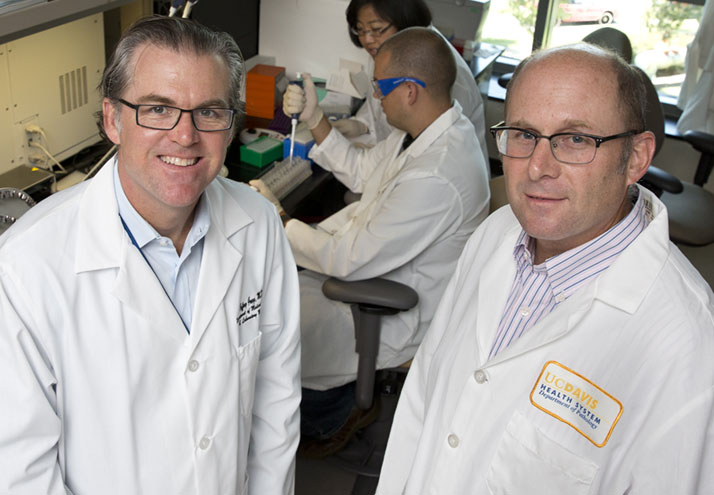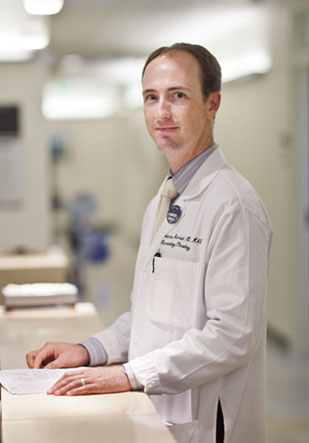
Cancer is secretive.Tumors grow without us knowing, migrate and hide in other organs and resist treatments for reasons we don’t fully understand. For years, a major clinical and scientific goal has been to drag cancer into the light. We are almost there.
Clinicians and researchers at UC Davis now have a state-of-the-art genome sequencing tool to expose cancer, technology that can quickly read cancer genomes and tell us which mutations are making it grow and spread; providing, in essence, a shop manual for tumors that clinicians can use to guide treatment.
A genomic revolution
When talking about cancer, clinicians and researchers speak a different language. They use abbreviations like EGFR, KRAS, PI3-kinase and many others, references to the mutated genes and proteins that drive cancer birth, growth and metastasis. Entire generations of scientists have devoted their careers to understanding how these mutations generate disease, but that knowledge hasn’t always translated into improved patient outcomes. However, recent advances in genomics — the ability to read the letters in a DNA sequence — will soon allow clinicians to translate this information into better patient care.
“We’re creating gene panels that will identify the mutations in each patient’s cancer,” says Clifford Tepper, technical director of the UC Davis Comprehensive Cancer Center’s Genomics Shared Resource. “For any patient that comes in the door, we want to be able to precisely molecularly characterize their tumor.”
“For any patient that comes in the door, we want to be able to precisely molecularly characterize their tumor.”
“Genetic sequencing can analyze all the genes simultaneously and do it much faster.”
Though clinicians have been able to profile some cancer mutations, their range has been limited to one or two genes per test, an expensive and time-consuming process. In addition, biopsies haven’t always produced enough material to test for all relevant mutations.
“Genetic sequencing can analyze all the genes simultaneously and do it much faster,” says Jeff Gregg, professor and senior director of clinical pathology in the Department of Pathology and Laboratory Medicine. “We can then get the results to clinicians, who can start molecularly guided treatment significantly earlier.”
The new panels will analyze selected regions of a tumor’s genome rapidly, picking out mutations from as many as 400 choices. This approach, called massively parallel sequencing, will provide the big picture on a tumor and influence a variety of clinical decisions.
“This is a revolution in the way we approach and treat patients,” says gastrointestinal oncologist Thomas Semrad. “Patients will receive profiles to tailor the right treat-ments to their specific needs.”
Personalizing treatment
The new gene panels will read mutations that are “clinically actionable.” In other words, they will pinpoint genetic variations that directly affect patient care. This could mean finding a mutation that can be targeted by a specific drug, determining whether the cancer is resistant to treatment or precisely classifying a particular tumor.
“Once we get the results, we will create a detailed report,” says Tepper. “We’ll list and prioritize all the aberrations we find, the impact they have on protein function, which drugs target those specific mutations and whether there are any clinical trials available.”
With this genetic report, oncologists will have a powerful new tool to build a treatment plan. For example, a comprehensive list of mutations will tell them whether a given therapy will have any effect against a patient’s cancer.
“Certain mutations in the KRAS gene indicate that colon cancer will not respond to a particular antibody drug,” says Semrad. “If a patient’s cancer has that mutation, we know to administer a different treatment.”
Other variations might allow physicians to recommend less toxic treatments. Semrad notes that certain mutations in the EGFR gene in lung tumors allow patients to take an oral medication that is much gentler than traditional chemotherapy.
Equally important, the panels will provide more information than previous methods — like going from a magnifying glass to a microscope. This will expose mutations that are either uncommon or may exist in only a few cells.
“The beauty of the targeted approach is that we’re able to sequence at high depth — sequencing each gene a thousand times,” says Gregg. “If you have a rare mutation in a population of cells, the panel will pick that out.”
Finding new therapies
Genomic sequencing will also have an enormous impact on clinical trials and drug discovery. Limited genetic information has hampered oncologists’ ability to refer patients to trials. It simply does not make sense to test a potentially toxic drug on a patient who may not have the mutation being targeted.
“This gives us a great ability to survey all these genes and then put patients in clinical trials,” says Gregg. “We wouldn’t have been able to do this in the past because you have to demonstrate the patient has that mutation.”
In addition to helping patients, this new approach could boost clinical trial enrollment. Low participation can limit a trial’s ability to determine a therapy’s effectiveness, short-circuiting the ability to advance new therapies.
“This is going to be really great for patients participating in clinical trials because there are many trials for targeted therapies but, without sequencing, we might not test for that mutation,” says Gregg. “Having the additional information will get more patients into trials, and the larger cohorts will tell us more about a drug’s effectiveness.”
The future is now
The cancer center will start with two panels, a large 400-gene approach that encompasses mutations from multiple cancers and a more targeted, 55-gene panel for melanoma, lung cancer and other conditions. Eventu-ally, new panels will be designed to catalogue mutations from other cancers.
The researchers expect to implement the sequencing program in early 2014. The genomics facility will be housed in the Molecular Diagnostic Laboratory in the Department of Pathology and Laboratory Medicine and will be certified under CLIA, the standards all clinical laboratories must meet before testing patient samples.
In addition to investigating cancer, the new genomic capability will also help clinicians better target cardiovascular disease, seizure disorders, developmental delay and other conditions with genetic underpinnings.
“This is an amazing advance,” says Semrad. “We’ve come from sequencing the first genome for several billion dollars, and taking years to do it, to sequencing individual patients for only a few thousand dollars in less than a day. It’s going to change cancer care forever.”

